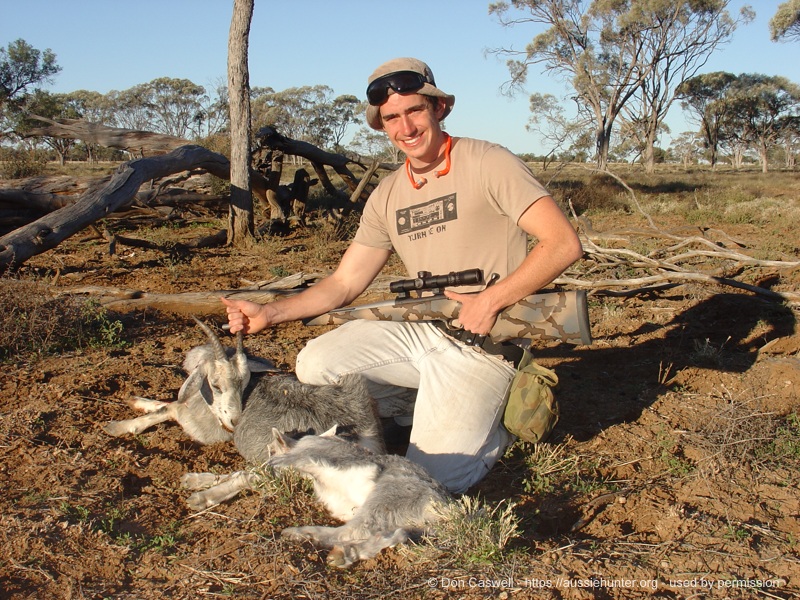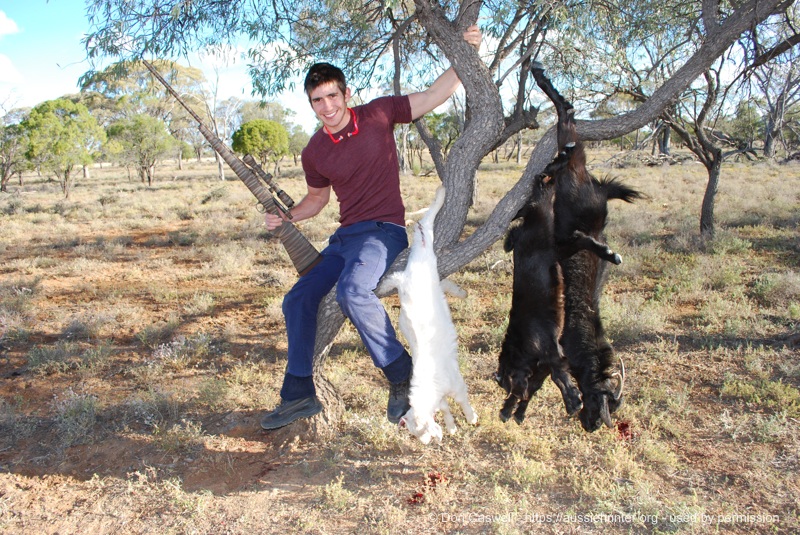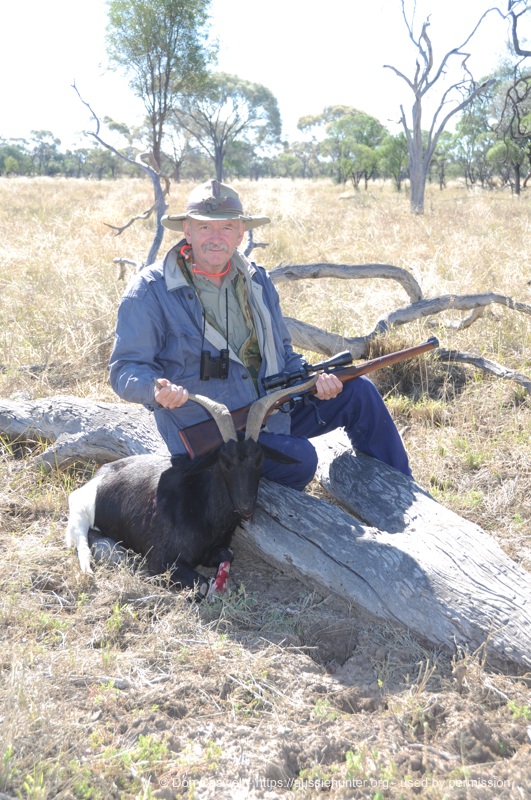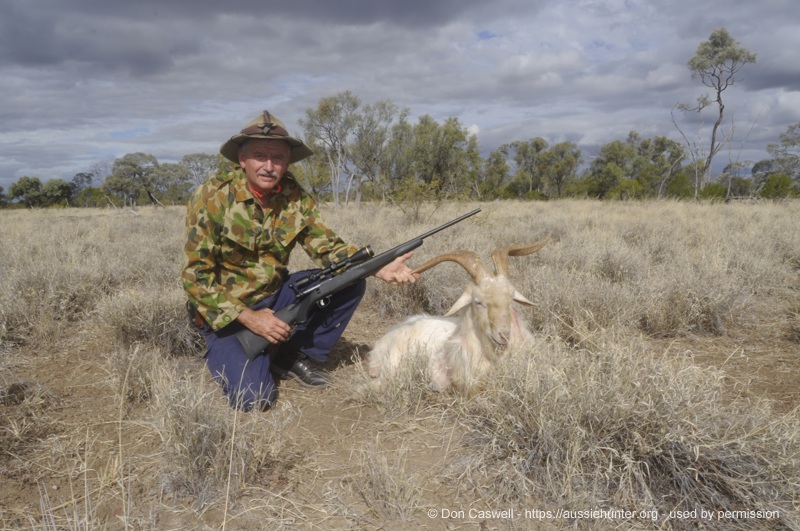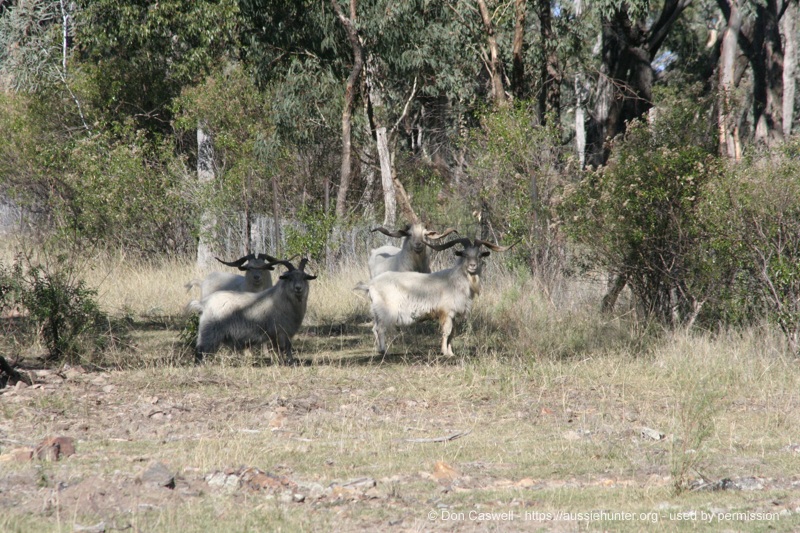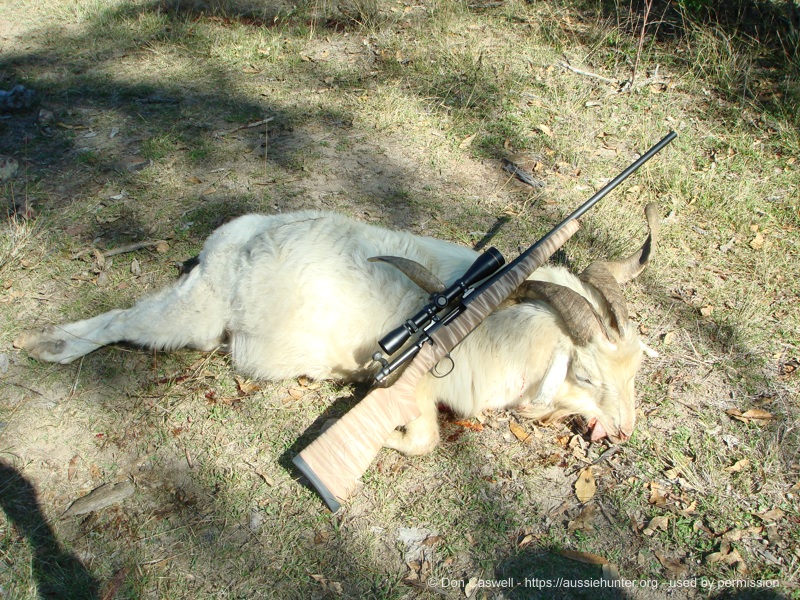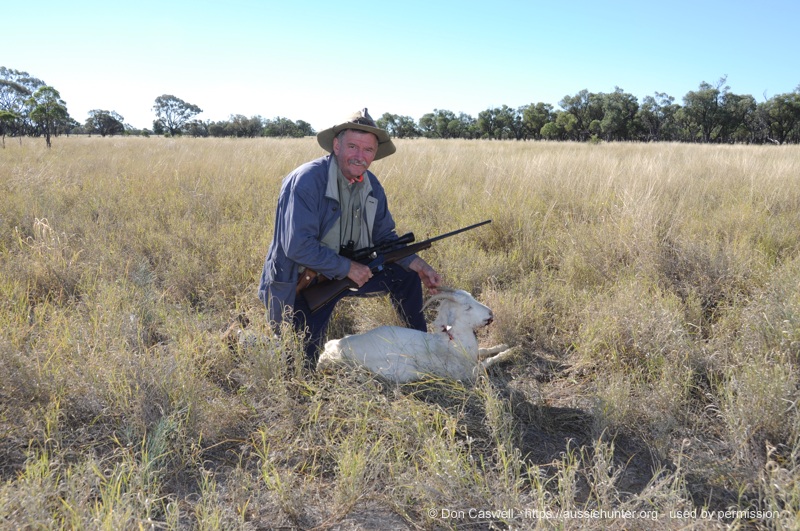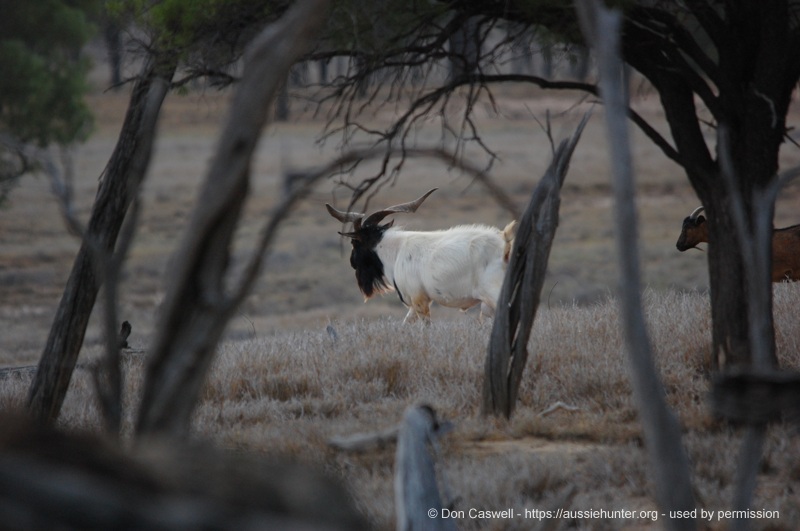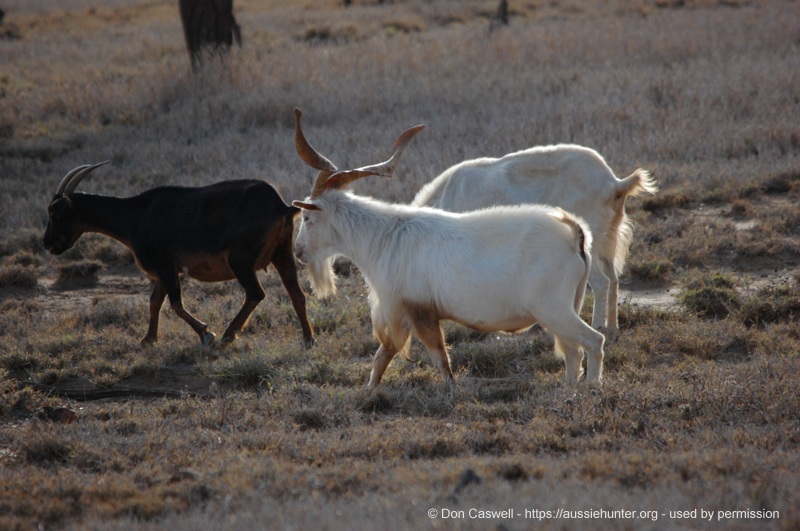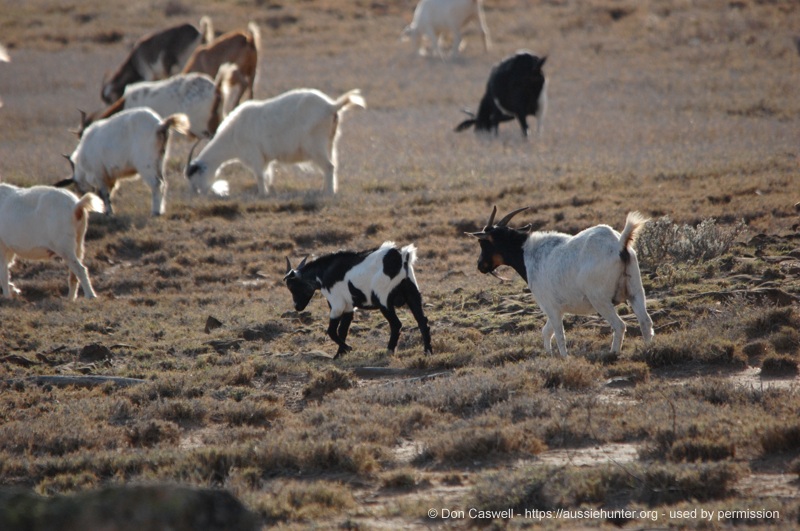Goats are a great mainstay for Aussie hunters. They can be found in all sorts of terrain and climate. They are rarely an easy quarry, learning fast and often proving to be very wary.
"Goats!" yelled my son Aaron.
"Nope, they'd be sheep," I pronounced without even looking. We were hunting on a merino sheep station where the owners had a nil tolerance for goats. If by some chance a few coarse goat hairs got in with the wool clip, and were picked up in the sample, it could prove to be a costly drop in premium for their fine merino fleece.
I had been hunting there on and off for twenty years and felt that we had about as much chance of seeing a unicorn as a goat.
"I reckon they're goats too," chimed in younger son Ryan.
I brought the four wheel drive to a halt and looked for myself. There was no need to get out the binoculars. A bit over half a kilometre away, out in the middle of the big western Queensland paddock, half a dozen unmistakable goats were standing on their hind legs and browsing a thorn bush.
We got out of the car to prepare for the hunt. My young teenage sons were having a good time and making the most of the old man's apparent inability to tell goats from sheep. Having donned back packs, water bottles and rifles I took the opportunity to get a little bit of revenge.
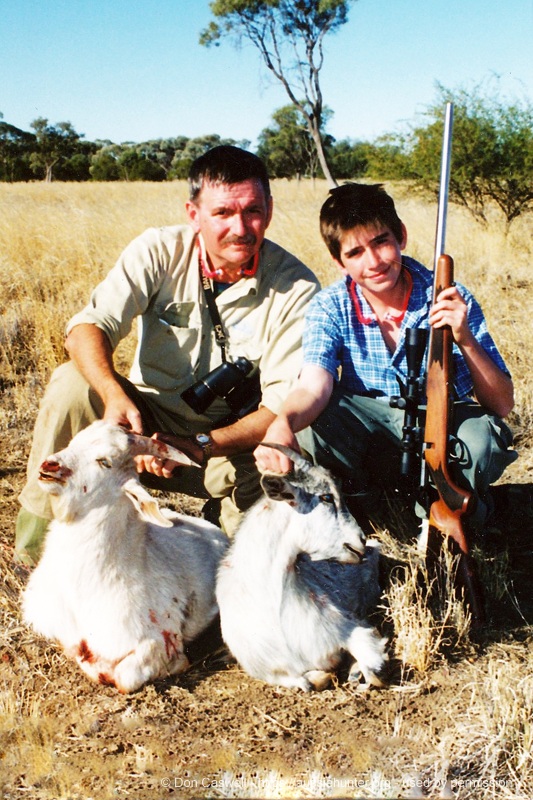
"Ryan you're in charge of getting us back to the car, so take note of the bearing, the fence line and where the sun is." I passed a compass to Ryan. I also took the GPS out of the car, as backup in case Ryan's navigation went astray. Ryan suddenly did not look so happy. Aaron sniggered at his brother's discomfort.
"And you are leading the stalk, so check out the wind and lead off."
"Water, knives, bags, rifles, ammo? Rifles unloaded?" Aaron asked the standard questions. Ryan and I confirmed and we set off.
I tailed along behind the boys as Aaron concentrated on getting us into a good position for a shot. I was pleased to see that he took us well into the wind in order to get the afternoon sun right behind us for our final approach on the goats.
I was also pleased to see Ryan turn around occasionally to look back at where we had come from. A vital part of dead reckoning is having a good feel for where you are going. A few prominent features and the angle of the shadows can take you straight back to your vehicle without having to resort to compass or GPS.
It is easy country to misplace yourself in, and very unforgiving, so a measure of care with navigation is always worthwhile, no matter how exciting the hunting might be.
The goats were only about five or six hundred metres away and everything looked sweet for a quick stalk. But we knew from hunting goats elsewhere that they can never be taken for granted.
We have had hunts where a mob of goats just drifted along, with no sense of alarm, always just a bit out of range, and taking us many kilometres from the vehicle over a full half day. It never hurts to start what looks like an easy hunt with the presumption that you might end up doing a long haul.
On this occasion though everything went according to plan. After a slow and deliberate stalk using trees and shrubs for cover, Aaron got us to within about eighty metres of the goats. We had a hushed discussion about our battle plan. Aaron directed that and I only needed to query a few minor points.
The group was made up of young goats. There were no big billies or older nannies. Ryan was nominated to take first shot with the 223 while Aaron would take the second shot with the 22-250 then they would continue to alternate shots.
Having made sure they understood where they were to remain and shoot from and the rules, I drifted back off to the right a ways. After a last glance in my direction for the thumbs up, Aaron and Ryan fitted their ear plugs and loaded their rifles.
Ryan took his time to get comfortable and settled before he took his shot. A split second after he fired Aaron took a shot with the 22-250.
There was some confusion amongst the goats and the boys took advantage of that to drop another two before the survivors fled the scene. The boys were happy.
They had executed a well planned stalk and downed four goats cleanly with well placed shots. After a few photos we harvested the back straps and hind legs. Ryan had no trouble taking us back to the car either. It had been a valuable and rewarding afternoon in more ways than one.
That was near on fifteen years ago. The boys and I have repeated that hunt on the same property quite a few times since then. Recently Ryan and I found ourselves goat hunting there once more. Ryan was armed with a 223 Remington, although a different rifle this time.
We were actually chasing pigs when we saw a small mob of young goats. The location was only a few hundred metres from our much earlier effort. It did not take long to drop a few young goats and have them hanging from a convenient tree branch, ready for butchering.
Over the years we have hunted goats in quite a range of territory. Each has its own challenges. I must admit that as I get older I am starting to notice the effort required when chasing goats in the rugged, scrub covered hills and gullies of the Great Dividing Range.
As much as I love the scenery, views and the hunting, as we poke about with fast handling close-range rifles, the legs and lungs are protesting more each time I indulge in that particular style of goat hunting.
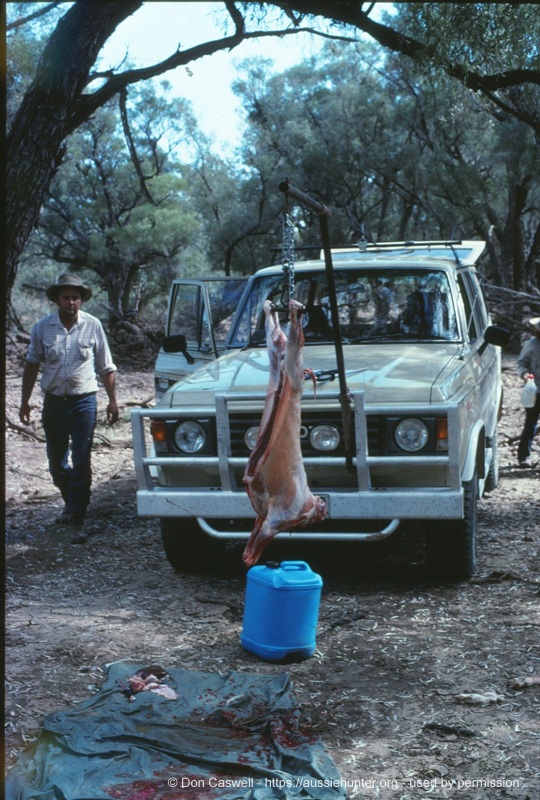
There was one particular property I used to hunt that bordered on a large national park. Typically, the park was an uncontrolled cess pit of noxious weeds and feral animals. The property owners, and their neighbours, had erected a high netting fence to try and keep the park vermin in the park, but it was a losing battle. You could sympathise with their frustration while at the same time enjoying some great hunting opportunities.
As fast as the fence was repaired the park goats, pigs and deer would make a new breach. The start and end of each day was spent in a patrol up the long boundary fence. It was a rare day when we did not see a variety of game coming and going through the boundary.
Over the years we shot quite a few good billies, pigs, foxes and not a few deer that way. After the morning fence patrol we would then go foot slogging about the gullies and ridges.
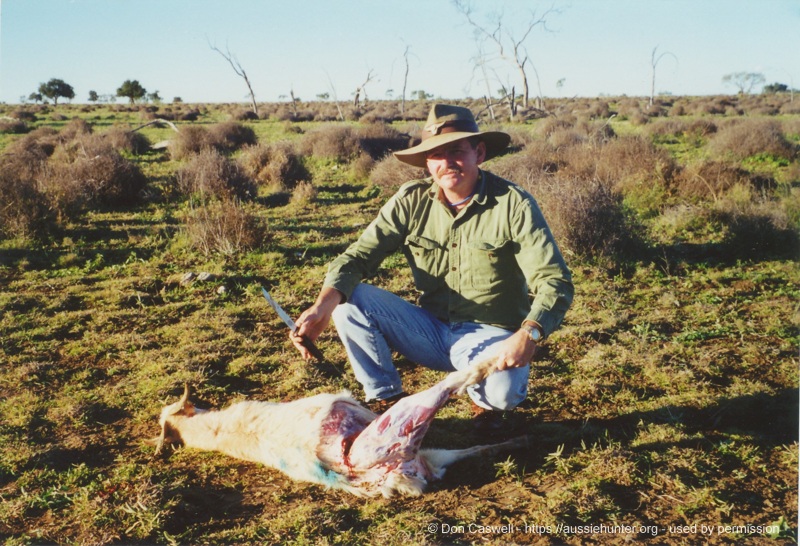
Fences anywhere are always worth exploring. Even out on the western plains, where the standard stock fences do not provide any real impediment to athletic critters like goats, the fence lines deserve some inspection. Ferals such as deer, goats and pigs are often creatures of habit and will wear a path through a favoured fence crossing point.
These trails are used by other creatures as well will often show the tracks of foxes and wild dogs. Sometimes strands and tufts of hair caught on the barbed wire are also giveaways to popular crossing spots. These spots are well worth stalking and setting up for an ambush, particularly in the mornings and afternoons when the animals are often on the move.
People hunt goats for a variety of reasons, some for trophies, some for skins, others for meat. Mostly I look to shoot young adults, or even kids, for their meat. On properties where the owners consider goats a pest I will also shoot billies and any nannies that don't have kids with them.
You need to make sure that the property you are shooting on does consider goats to be a pest before you start shooting. I have a couple of places where they don't mind me knocking off the odd youngster for meat but otherwise ask me not to disturb the goats. Those properties are devoted to cattle raising and the owners do not see the goats as any sort of competitor to that business.
In fact, the owners liked the way the goats browse on the thorny shrubs. The goats do have a commercial value as well. Every now and then they muster up the feral goats and sell them off.
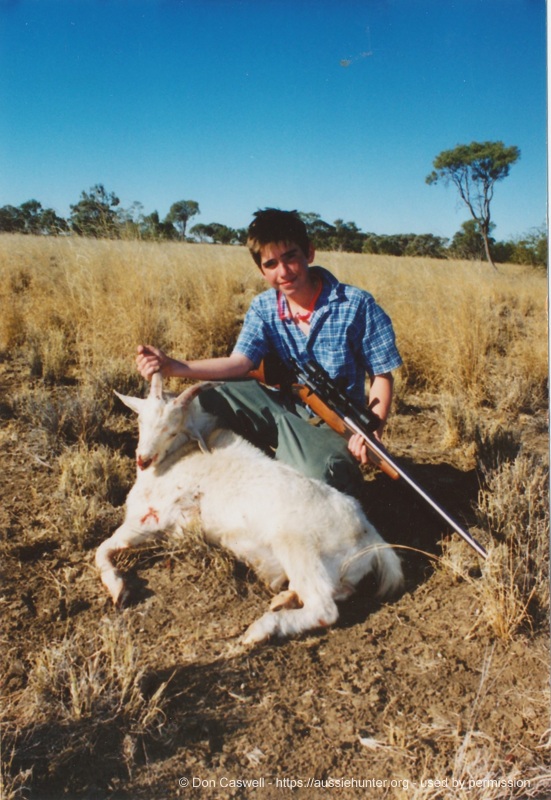
My boys were keen to collect a few billy goat horns when they were young and I felt obliged to help them with that trophy quest. On approaching the first big billy they had shot the boys quickly found out why the common name for them is "stinker". It was a big black billy goat with a reasonable set of horns. He had an aroma that was detectable upwind at about twenty metres; a powerful, eye-watering stench with a penetrating ammonia sharpness.
On learning that it wasn't just Dad's problem, and they needed to be actively involved in the trophy gathering exercise, a revised plan was hastily contrived. Wisely we reckoned that wrestling with that old billy would leave our clothes imbued with a smell unlikely to ever come fully out in the wash. And don't even think about sneaking them home to slip in with the rest of the laundry!
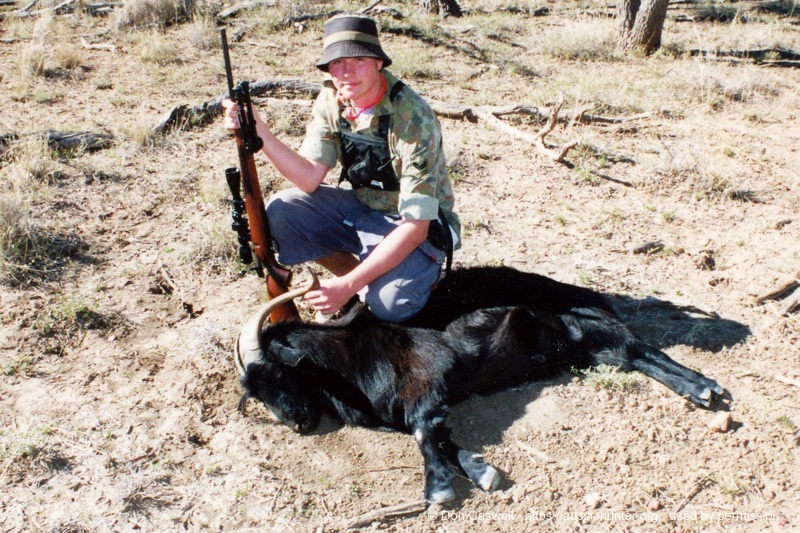
It was a big property and we were the only shooters allowed on the place. We had stalked the goats on foot for hours and we were way out in the middle of a big paddock, far from any vehicle tracks. There was no chance of anybody finding, or wanting, the boys' trophy so we decided to let nature do the hard work for us.
That simply meant dragging the billy over to a convenient dead log and wedging his head in the fork of a big branch. A couple more hefty sticks were used to lock it all tightly in place. We only needed to drag the billy about fifty metres to get him in position. That's when the boys discovered the other fact about big old billy goats. They seem to weigh much heavier than they look.
I have dragged my share of boars out of dams and creeks and have a good sense of what effort is required to move a 90 kilogram pig. I don't know what it is, but pigs seem to be easier to shift, kilo for kilo, than goats. I guessed that the black billy probably weighed about 80 kilos but by the time the boys helped me get him dragged over to the fallen timber and wedged in place I would have swore he weighed half a tonne!
This little exercise was also a useful opportunity in other ways. I passed the GPS to Aaron and he set about recording the location of his trophy. On our return in the next winter one of the first things we would do would be to walk back to the spot and reclaim those horns.
Over that time nature had done a perfect job. A perfectly bleached skull with the horns still loosely in place was sitting firmly in the forked branch. Underneath was a great mat of black hair scattered with white bones.
In my hunting I always keep an eye out for goats. I am rather partial to some tender young goat meat and quite enjoy the challenge of hunting them. Goats are a very robust animal and need good shot placement and appropriate projectiles no matter what calibre you are using.
Over the years I have shot goats with 223, 22-250, 243, 270, 270 WSM, 260, 7x57 and 7mm Rem Mag. A long term favourite has been the 223 Rem for goats. For many years I limited my shots to the smaller animals I was culling for meat.
Lately however, with a new Savage rifle featuring a 1:9 twist barrel and premium projectiles like the Nosler Partition, I have used my 223 Rem to take the bigger bodied billies effectively.
Whatever calibre you opt to employ, and whatever your reason for pursuing goats, you will find them a challenging and rewarding game animal.
© Don Caswell 2014
This story first published in the SSAA Hunter magazine, edition 51 in December 2014
About the author
Since 1981 Don Caswell has been a freelance writer, photographer & illustrator. Don is the author of hunting stories and the provider of technical shooting information. Don an independent reviewer of hunting, shooting & outdoors products, in addition to being a blogger & webmaster with Facebook & Instagram presence. Don is also a senior writer for the Sporting Shooters Association of Australia (SSAA) and his articles appear regularly in their publications. This article was originally published in the SSAA in April 2014.
Visit Don Caswell's Aussie Hunter Website here

